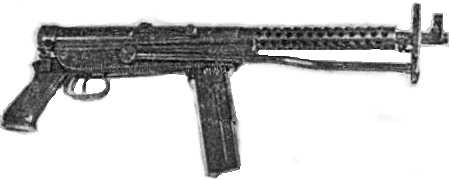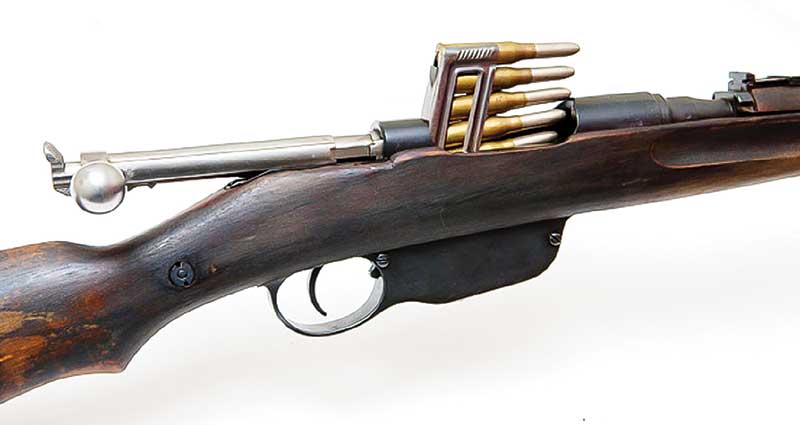Gebauer Tank Machine Gun 1934/37.M
Gebauer Harckocsi Motorgéppuska 1934/37.Minta GKM
 This gun was the same as the 34.M, but slightly modified for tank use. The 100-round drum magazine was retained. This gun was also called 34.AM. It was chambered for the 8x56R 31.M ammo. Both single or twin configurations were used in tanks. Among other Armored Tanks, this gun was utilized in the Fiat Ansaldo light tanks, Csaba armored vehicles and Toldi tanks. After 1942 it was also used on gunboats and patrol boats. The 34/37.M’s were also used for air defense on the boats, so these guns were equipped with large round anti-airplane sights.
This gun was the same as the 34.M, but slightly modified for tank use. The 100-round drum magazine was retained. This gun was also called 34.AM. It was chambered for the 8x56R 31.M ammo. Both single or twin configurations were used in tanks. Among other Armored Tanks, this gun was utilized in the Fiat Ansaldo light tanks, Csaba armored vehicles and Toldi tanks. After 1942 it was also used on gunboats and patrol boats. The 34/37.M’s were also used for air defense on the boats, so these guns were equipped with large round anti-airplane sights.
Submachine Gun Cristobal Carbine Model 1
Pistola Ametralladora Cristóbal Modelo 1

Manufactured by Armeria San Cristóbal, Dominican Republic 1949-50
Quantity: 200,000 combined with the Modelo 2
Caliber: .30 US M1 Carbine [7.62x33] rimless and possibly 9mm Luger
Auto-loading action, delayed blowback
945mm [37.2"] overall, 3.51kg [7.74 lbs] without magazine
410mm [16.14"] barrel, 4-groove rifling; RH, concentric
Detachable box magazine, 30 rds
Spring-leaf and elevator sight
564 m/sec [1850 fps] with standard ball cartridges; 250 rpm
The first Cristóbal Submachine gun was the Modelo 1. It was almost identical to the Hungarian Danuvia Machine Pistol 44.M. Most sources claim the Modelo 1 is a simplified version of the Danuvia Machine Pistol 43.M which is not completely incorrect, but shows their lack of knowledge about the 44.M. The 44.M had no stock, the Modelo 1 is a close copy of the 44.M with a folding stock. Also, the ‘experts’ statement, that the Danuvia and Cristobal machine guns were ‘inspired by the Swiss SIG MKMO’ needs to provide the proper credit, that Pál Király, the designer of the Danuvia and Cristóbal guns WAS working for SIG at that time, as the co-designer of the MKMO.
At first the gun was actually called ‘Király-Cristobal Carbine’, but the designer’s name was dropped at the end of 1951, apprently for marketing reasons: the gun was mainly marketed in Latin America.
This gun’s design was patented by Pál Király. It was a delayed blowback utilizing a simple lever system. The bolt was engaged with the receiver by a pendant lever. When the bolt is blown back by the force of the exploding cartridge it revolves the lever and disconnects before recoiling freely. This achieves the necessary delay for bullet travel before extraction. It had two triggers: the front trigger for semiautomatic firing and the rear trigger for firing full automatic.
Internally, a lever connected the lightweight bolt head and the heavy body. When the gun fired, the resistance of the lever had to be overcome before the bolt body began to move backward, delaying the opening of the breech until the chamber pressure had dropped to a safe level, much the same system had been used in Király’s Hungarian Danuvia Machine Pistols a decade earlier.
Submachine Gun Cristobal Carbine Model 2
Pistola Ametralladora Cristóbal Modelo 2
 Manufactured by Armeria San Cristóbal, Dominican Republic, 1950-61
Manufactured by Armeria San Cristóbal, Dominican Republic, 1950-61
Quantity: 200,000 combined with the Modelo 1
Caliber: .30 M1 Carbine, rimless
Auto-loading action, delayed blowback
945mm [37.2"] overall, 3.55kg [7.8 lbs] without magazine
412mm [16.2"] barrel, 4-groove rifling; RH, concentric
Detachable box magazine, 25 or 30 rds
Spring-leaf and elevator sight graduated 100-600 meters
572 m/sec [1876 fps] with standard ball cartridges; Rate Of Fire: 550 rds/min theoretical, 250 rpm actual
No bayonet
The Modelo 1 had a safety problem. A sharp blow to the gun may set it off firing and injuring the soldier if there is a round in the chamber. Several leg injuries were reported using this weapon in 1950. The trigger system was quickly redesigned and this problem was eliminated on the Modelo 2. Due to the influence of former Beretta engineers at the factory, the the modern folding metal stock was replaced with an outdated style wooden stock and handguard, similar to the Beretta M38, effectively changing the design from a machine pistol to a machine carbine. The wooden stock caused barrel overheating, but the stubborn Beretta engineers did not allow it to be changed until 1961 with the Modelo 3. The gun has a battle range up to 300 meters and a maximum range of 1500 meters. The practical rate of fire by bursts is of 110 firings per minute.
 The Modelo 2 was adopted by the Dominican Army and the National Police in 1950. For marketing purposes the Trujillo government organized the Fair of La PAz in 1954. These arms were offered for export to the military delegations attending the exhibitions of Dominican Arms. The first export order of 1500 guns came from the government of dictator Red Gustavo Pinilla of Colombia. These carbines were popular in Central America, the pre-Castro Cuban government was the largest purchaser of Cristóbal Arms. A semiautomatic only version with a single trigger called Modelo 2M was also offered.
The Modelo 2 was adopted by the Dominican Army and the National Police in 1950. For marketing purposes the Trujillo government organized the Fair of La PAz in 1954. These arms were offered for export to the military delegations attending the exhibitions of Dominican Arms. The first export order of 1500 guns came from the government of dictator Red Gustavo Pinilla of Colombia. These carbines were popular in Central America, the pre-Castro Cuban government was the largest purchaser of Cristóbal Arms. A semiautomatic only version with a single trigger called Modelo 2M was also offered.
A special nose cap with a bayonet lug for a Mauser-type bayonet was used by special services, such as Police and Prison Guards.
Parts description from a Dominican Army Spanish manual:
The Carbine Cristóbal M2 consists of 9 parts groups:
Barrel Group: Includes the chamber, the barrel, barrel shroud
Operating Group: Includes the bolt handling, cartridge ejection, magazine latch, bolt manipulator and other operating parts, 12 parts total
Trigger Group: Trigger guard with the firing gear and firing mode selector, burst firing disconnector, 8 parts total
Bolt Group: 17 parts total to make the operation of the bolt
Front Sight Group: the front sight, its base, pin and sight protector, 4 parts total
Rear Sight Group: the base, the ladder, the slide, 3 parts
Wood Group: buttstock and handguard
Sling Group: Strap, 2 clasps, strap clip, support
Magazine Group: parts of the detachable magazine
Operating instructions from a Dominican Army Spanish manual:
In order to load and to unload the Carbine support it with your left leg with the trigger guard towards the right and hold it with your left hand by the handguard. With your right hand insert the magazine into its place in the receiver, until it fits with a clicking sound. Familiarise yourself with the correct sound of a correctly attached magazine. To unload the carbine: hold it the same way described above. With your right hand hold the magazine and with your thumb press the magazine latch inwards until it releases the magazine. Operate the bolt to make sure no round is left in the chamber.
Submachine Gun Cristobal Carbine Model 3
Pistola Ametralladora Cristóbal Modelo 3

Manufactured by Armeria San Cristóbal, Dominican Republic, 1961-62
Quantity: less than 1000 for trials
Caliber: 7.62x51 Nato
Auto-loading action, delayed blowback
Detachable box magazine, 20 rds
FN export-pattern knife bayonet, Mauser rifle type
Király developed the Model 3 in 1961 as a competitor with the Belgian FN-FAL, an assault rifle using the more powerful 7.62X51mm NATO ammo. By 1961 service showed that the Modelo 2 overheated in automatic fire. The improved Modelo 3 (or ‘Mk 3’) discarded the original wooden hand guard for a perforated sheetmetal fore-end and the gun could accept an FN export-pattern knife bayonet. A number of guns were also made with a tubular folding butt. This rifle had the gas tube and regulator was underneath the barrel. The ammunition box was vertical, not inclined like the carbine. After Trujillo’s death (assassination), the new Dominican government was not interested in Dominican weapon manufacturing and the M3 was not adopted by the Dominican Armed Forces.
Submachine Gun Cristobal Carbine Model 1962
Pistola Ametralladora Cristóbal Modelo 1962

Manufactured by Armeria San Cristóbal, Dominican Republic, 1962-65
Quantity: 10,000?
Caliber: .30 M1 Carbine, rimless
Auto-loading action, delayed blowback
945mm [37.2"] overall, 3.55kg [7.8 lbs] without magazine
412mm [16.2"] barrel, 4-groove rifling; RH, concentric
Detachable box magazine, 30 rds
Spring-leaf and elevator sight
570 m/sec with standard ball cartridges; 250 rpm
FN export-pattern knife bayonet?
The Model 1962 had a retractable butt similar to the US. M1 Carbine. This was a single trigger semiautomatic only weapon. The original Modelo 1 perforated handguard design was re-introduced. The quality and workmanship of these guns was lower than the previous models’, but they remained popular.
The Model 62, was produced from 1962 until 1965. After Trujillo’s death in 1961, the new Dominican government was not interested in Dominican weapon development and manufacturing. These carbines remained in Dominican military service until 1990, although they were gradually replaced by more modern weapons. They remained in use as training weapons.


































 This gun was the same as the 34.M, but slightly modified for tank use. The 100-round drum magazine was retained. This gun was also called 34.AM. It was chambered for the 8x56R 31.M ammo. Both single or twin configurations were used in tanks. Among other Armored Tanks, this gun was utilized in the Fiat Ansaldo light tanks, Csaba armored vehicles and Toldi tanks. After 1942 it was also used on gunboats and patrol boats. The 34/37.M’s were also used for air defense on the boats, so these guns were equipped with large round anti-airplane sights.
This gun was the same as the 34.M, but slightly modified for tank use. The 100-round drum magazine was retained. This gun was also called 34.AM. It was chambered for the 8x56R 31.M ammo. Both single or twin configurations were used in tanks. Among other Armored Tanks, this gun was utilized in the Fiat Ansaldo light tanks, Csaba armored vehicles and Toldi tanks. After 1942 it was also used on gunboats and patrol boats. The 34/37.M’s were also used for air defense on the boats, so these guns were equipped with large round anti-airplane sights.
 Manufactured by Armeria San Cristóbal, Dominican Republic, 1950-61
Manufactured by Armeria San Cristóbal, Dominican Republic, 1950-61 The Modelo 2 was adopted by the Dominican Army and the National Police in 1950. For marketing purposes the Trujillo government organized the Fair of La PAz in 1954. These arms were offered for export to the military delegations attending the exhibitions of Dominican Arms. The first export order of 1500 guns came from the government of dictator Red Gustavo Pinilla of Colombia. These carbines were popular in Central America, the pre-Castro Cuban government was the largest purchaser of Cristóbal Arms. A semiautomatic only version with a single trigger called Modelo 2M was also offered.
The Modelo 2 was adopted by the Dominican Army and the National Police in 1950. For marketing purposes the Trujillo government organized the Fair of La PAz in 1954. These arms were offered for export to the military delegations attending the exhibitions of Dominican Arms. The first export order of 1500 guns came from the government of dictator Red Gustavo Pinilla of Colombia. These carbines were popular in Central America, the pre-Castro Cuban government was the largest purchaser of Cristóbal Arms. A semiautomatic only version with a single trigger called Modelo 2M was also offered.


